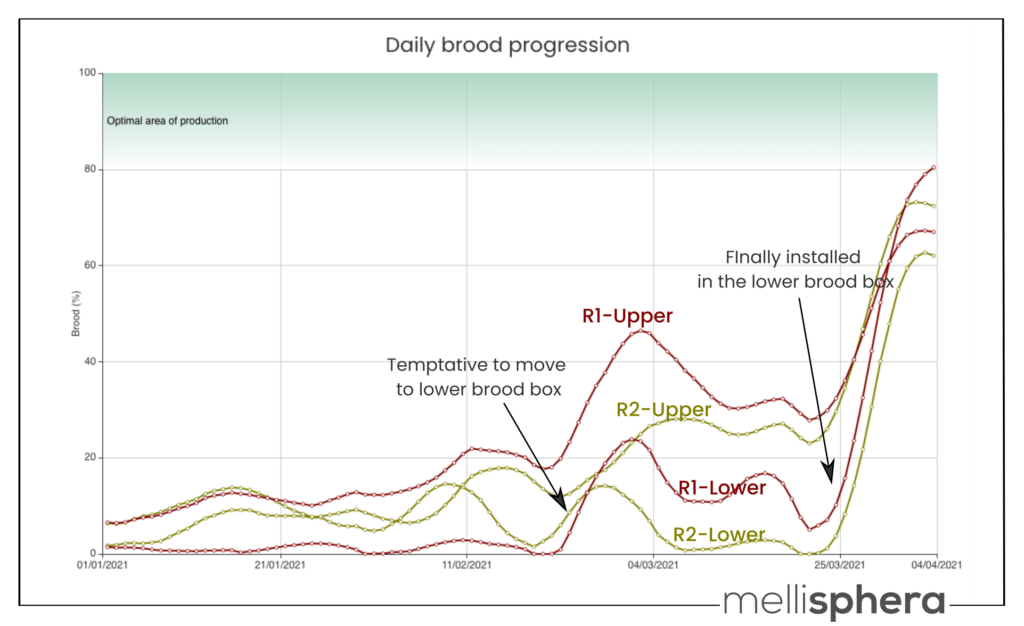Monitoring hives in April is wonderful as much as a delicate exercise. We're illustrating it here with three examples issued this season. From the exit of a harsh winter in Slovakia, to a split sacked by its neighbors in Béarn, or a promising F1 queen, so sharp that it succumbs to the rigors of the changing weather in the Gers region.
As the weather gets warmer, bee colonies wake up from their lethargy. It is an exciting period and also a critical one for them. Bees have to combine their desire to grow with the risk of an eventual cold wave threating their survival. And they are bussy! fill in the hive, launch brood, ensure resources... a job that bees have been doing for thousands of years and which still holds so many mysteries for beekeepers.
Rising up after the Slovak winter
Central Europe is a hot spot of beekeeping, despite the harsh and demanding winters. With minimum temperatures down to -12°C the last winter, colonies have to be carefully managed to get through the period.
To do so, double-body overwintering can be a good practice. In normal conditions bees go upstairs to huddle against the ceiling on one side of the hive. Then, when the warm weather is back the colony starts her development in this location and gradually "conquers" the rest of the available volume.

One of the major events is therefore the (re)descent of the colony into the lower-body. This practice is also common in France. Well known for those who work with Langstroth.
When does the colony go down to the lower-body and how does it happen? It is hard to know unless you have your nose permanently in the hives (and to see the lower body you have to remove the upper one, not much practical either). But a beekeeper near Bratislava who equipped his hives with two internal BroodMinders, one per body, shows us what this maneuver of the Queen Bee can look like.

Two hives are displayed in the graph above showing the brood timeline progression: R1 (red) and R2 (green) Clearly the bees went upstairs to spend the winter and came down again in early spring. For R1 the first attempt took place on February 21 and for a week until March 1 it started. But from the 1st of March the minimum temperatures, which until then were of 1°C, went down again to -5°C to -7° during one week and there was the sound of a retreat.
Hive R2 followed more or less the same logic. On the whole it is a little less strong, but had already gone down once at the end of January.
And then, around March 25, in barely 7 days, the magic happens. Not only it moves to the lower body, but it also climbs up very fast: it is time to light the engines!
Have the environmental conditions really improved for this event to take place? Well, not really. As you can see below, the minimum temperatures remained around 0°C for several days. As for the maximums, indeed we crossed the 14 to 15°C some rare days (see the hive on Beecounted.org)
So the colony is committed: "We'll move ahead and see" says Ms. Queen. Runing hive monitoring in the Slovak April means making sure that they make it through the winter without any problems.



When F1 rhymes with Formula 1
We change sector, back to France to follow two colonies located in the Gers. Here we will call them G1 and G2. The G1 is a F1 queen, a 'race beast', a bomb, choose the qualifier you like. The G2 is also from a good family but a little more local.
On February 11, G1 already had 40% of brood on the counter, displaying a very good development compared to some of her neighbors (not shown).
But G1 lack efficiency and consumes quite a lot of oil, so it has to pass often through boxes to fill up with gas our F1. And when the weather gets tougher and we have a second week of cold weather on April 6, 7 and 8 with 1.3, -2.3 and 1.6°C of minimum, she can't bear it anymore and simply collapses.

The relentless law of nature, which has been making its selection for millions of years, still applies on earth.
While next to her, another colony G2, perhaps with a more rustic queen, leads her way. She is strong but also thrifty, knows how to manage herself and goes through the period without effort.

For the professional beekeeper who runs the operation, these events are not pleasant. Nevertheless, although he lost the investment on his F1 he knows how to explain what happened. He has gained control and considers it an opportunity. If the F1 queen had been successful, in a few years the whole apiary would have inherited its genetics.
He can now rely on other colonies that show better resilience facing hazards. For the professional beekeeper, monitoring the hives in April means mastering breeding and selection.
Split at risk
So here is one last case for April, this one is our own apiary case so let's just say we caught it.
The A hive is the result of a division among others, made on March 30. Its only specificity is to be a 5-frame hive while the others have 6-frames.
It was also fed with a little syrup like other hives, which are right next to her... all the same.
But, it happened that on April 2 we noticed a great excitement in front of the hive (see picture). Many bees and not all of them quiet. Something was wrong and indeed it was being sacked by the neighboring bees.

And here is how the splitted 3 brood frames went into nothing in only 4 days.

This is a picture of the colony after the battle (so to speak). The few bees that appear are dead, frozen by the cold of the night certainly.

They tried to warm up as best they could, but without any store, it was not enough.

For the backyard beekeeper, hive monitoring in April means properly managing splits while ensuring peace in the apiary!
Monitor for a better understanding
Here are three stories, three cases among dozens that can happen and that all have in common the fight of bees for survival. Nature is implacable and the beekeeper can sometimes be caught off guard. Monitoring the colonies does not always prevent the worst, but very often helps understanding what has happened. This is the long and endless way of learning!

